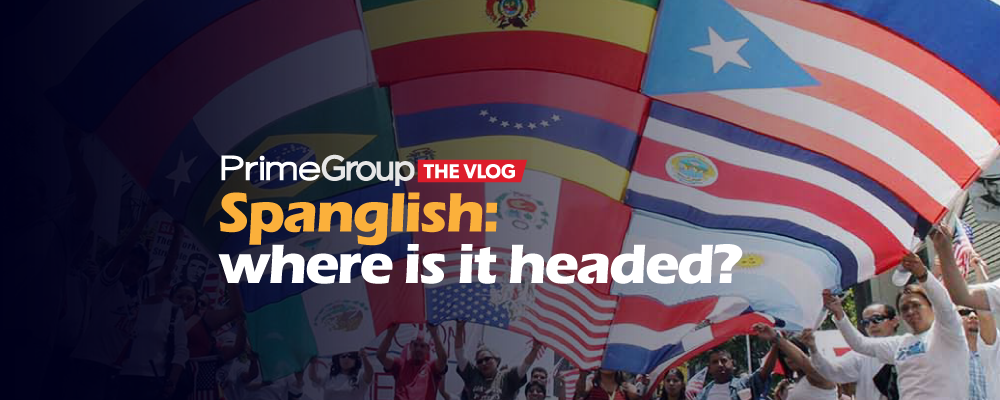Spanglish is that spicy, sometimes tasty, sometimes indigestible mixture of Spanish and English that we hear so much in the United States and other countries with many speakers of both languages. Do you want to know more about this hybrid linguistic variety that has already conquered the world thanks to music despite violating the rules and idiomatic purity? Stay with us and discover the controversial but fun Spanglish!
Spanglish is a linguistic phenomenon mixing Spanish and English in everyday communication. This spontaneous pairing of the two European languages has emerged in the United States and other countries with significant speakers of both languages. Let’s think of Gibraltar, areas of Honduras and Costa Rica, and of course, the entire North of Mexico. Influenced by the Internet and technology, people often tend to absorb terms in English because they ignore specific Spanish words.
Who are the people that speak Spanglish? Well, it is not only immigrants or American citizens with low education but also young people who have been educated in expensive bilingual schools and have used English as the primary language for history or geography. Or simply because it’s “cooler” for them to insert the odd little expression in English.
In short, we will address how this Spanglish has emerged, evolved over time and what its future could be.
The mixture of Spanish and English is a phenomenon that has been around for a while. In the United States, examples of this type of mixing can be found several centuries ago. It must be said that the first European language spoken in that territory was not English but Spanish: Ponce de León arrived in Florida in 1520. John Smith arrived in Virginia in 1607. A few Hispanic settlers and numerous indigenous tribes already spoke in Spanish when the English arrived in North America. Did you know that the Indian Geronimo spoke Spanish?
In the 19th century, the border between Mexico and the United States moved west, and speakers of Spanish and English found themselves in increasingly frequent contact. From Texas to California, but also in enclaves of Louisiana and Florida, words and expressions arose that combined both languages.
But Spanglish, as we know it today, began to emerge in the late 20th century because of the growing presence of Spanish-speaking and bilingual people in the United States: Puerto Ricans in New York, Cubans in Florida, Mexicans in California, etc. In the 1980s and 1990s, Spanglish became even more visible in the media, music, and popular culture. Songs like “La Bamba” by Los Lobos or “Livin’ la Vida Loca” by Ricky Martin included words and expressions in English mixed with Spanish.
Spanglish integrates English words and expressions into a Spanish sentence and vice versa. Let’s see more characteristics and examples of this mestizo or hybrid speech that is already on the lips of many millions of people.
Substitution of Spanish words by their equivalent in English. For example, “Te gusta mi nuevo sweater?” which means “Do you like my new sweater?”.
Use of words and expressions in English that are integrated into a sentence in Spanish. For example, “Voy a hacer shopping” means “I’m going shopping.”
Creation of new words that combine elements of both languages. For example, “troca” instead of “camioneta,” which means pickup truck, or “lonche” instead of “lunch.” “Guachiman” instead of Vigilante, which means watchman.
Use of words in Spanish with a meaning different from the original. For example, “estar constipado” is suppose to mean “to be constipated.” But in Spanish, constipation means to have a cold. The best is this: vaciar la carpeta, from vacuum the carpet; this sounds funny because in Spanish, it would be aspirar la alfombra, while vaciar la carpeta would mean literally empty the folder. This one is my favorite: deliberar las groserías is supposed to mean deliver the supermarket purchases, but deliverar las groserías, would mean something like express your insults… It’s funny but also absurd.
We have heard these examples, which denote a phenomenon of acculturation by Spanish speakers. In fact, it must be said that Spanglish is not accepted by most Spanish and English speakers. Because it’s a form of “language poverty,” a degraded language, and most people, consider it essential to keep the two languages separate and pure.
As for its future, it is difficult to predict with certainty what will happen to Spanglish. Some experts believe it may continue to evolve and expand as more Spanish speakers interact with the English language and culture. There are already 50 million Hispanics in the United States. Others suggest Spanglish is the manifestation of a retreating Spanish, crushed by English because as Spanish speakers become more integrated into American society and culture, English becomes more dominant.
However, in the field of music, it is possible to foresee a real fusion between Spanish and English. It can already be seen in artists like Pitbull, Bad Bunny, J Balvin, or Shakira herself, who mix both languages in their songs in a fluid and natural way. This fusion can also be seen in the use of Spanish terms in American popular culture, such as “taco Tuesday” or “fiesta.”
I couldn’t believe it when I found out, but it turns out that there are hundreds of words of Spanish origin in the English language. Look at this list… Fiesta, Siesta, Adiós, Plaza, Salsa, Sombrero, etc, etc…
This crossover between the two languages may be reflected in a greater acceptance of Spanglish in the future. As the Spanish-speaking population in the United States grows, Spanglish might be used as a form of everyday communication, but primarily informal and familiar. Its use may be acceptable or inappropriate, depending on the circumstances. But who knows, it’s also possible that Spanglish will evolve into its own language variety, a melting pot language with its own rules and conventions. What do you think? I appreciate your comments below.



